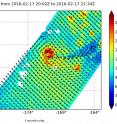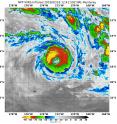NASA sees Tropical Cyclone Winston U-turn toward Fiji
Tropical Cyclone Winston made a U-turn in the Southern Pacific Ocean just north of Niue, and appears to be headed back toward Fiji. On Feb. 18, the gale warning for Niue has been cancelled now that Winston has moved west. However, a tropical cyclone alert is in force for Fiji, specifically the Lau group, Taveuni, Lomaiviti group, eastern half of Viti Levu, Kadavu. In Tonga warnings remain in effect. A storm warning is in effect for Vava'u and a gale warning is in effect for Niuatoputapu, Ha'apai, Tongatapu and 'Eua.
At 1500 UTC (10 a.m. EST) on Feb. 18, Tropical Cyclone Winston's maximum sustained winds were near 100 knots (115.1 mph/185.2 kph). It was a Category 3 hurricane on the Saffir-Simpson Wind Scale, making it a major hurricane. Winston was located near 17.1 degrees south latitude and 172.3 degrees west longitude, about 182 nautical miles northwest of Niue. Winston was moving to the west at 7 knots (8 mph/12.9 kph) and generating wave heights to 28 feet (8.5 meters).
On Feb. 18 at 12:41 UTC (7:41 a.m. EST) NASA-NOAA's Suomi NPP satellite passed over Tropical Cyclone Winston and the Visible Infrared Imaging Radiometer Suite (VIIRS) instrument aboard saw very strong thunderstorms around the eye. Infrared date from VIIRS showed a large eye with tightly curved, strong bands of thunderstorms wrapping into the center. Strongest thunderstorms and coldest cloud tops were in the northwestern quadrant. Temperatures in storms there were as cold as minus 80 degrees Fahrenheit (minus 62.2 Celsius).
Animated enhanced infrared satellite imagery showed that Winston has a large, ragged eye with cloud-top cooling observed within the eye wall over six hours before 1500 UTC. When cloud top temperatures cool it means that the air is rising faster and stronger than before, pushing cloud tops higher into the troposphere (where temperatures are colder). Cooling cloud tops are an indication of a strengthening storm.
The Joint Typhoon Warning Center (JTWC) forecast expects Winston to strengthen to 110 knots (126.6 mph/203.7 kph) and then begin on a weakening trend from Feb. 19 as it tracks over cooler sea surface temperatures. By Feb. 20, Winston is forecast to run into increasing vertical wind shear which will also help to weaken the system.
JTWC calls for Winston to move closest to southern Fiji on Feb. 21. It is then expected to turn southeast. For updated warnings and information from the Fiji Meteorological Service, visit: http://www.met.gov.fj/aifs_prods/20036.txt.
Source: NASA/Goddard Space Flight Center
Articles on the same topic
- NASA's Terra satellite sees Tropical Cyclone Yalo coming to a quick endFri, 26 Feb 2016, 17:33:58 UTC
- NASA's Aqua satellite catches the birth of Tropical Cyclone YaloThu, 25 Feb 2016, 19:38:56 UTC
- NASA sees Winston winding down near Norfolk IslandThu, 25 Feb 2016, 19:38:38 UTC
- NASA sees strong vertical wind shear battering a weaker winstonWed, 24 Feb 2016, 18:13:03 UTC
- NASA sees pinhole eye seen in weakening Tropical Cyclone WinstonWed, 24 Feb 2016, 18:12:55 UTC
- NASA sees category 5 southern Pacific Tropical cyclone hit FijiMon, 22 Feb 2016, 19:22:30 UTC
- NASA sees major Tropical Cyclone Winston approaching FijiFri, 19 Feb 2016, 22:53:32 UTC
- NASA infrared imagery shows wind shear affecting Tropical Cyclone UriahFri, 19 Feb 2016, 22:53:23 UTC
- NASA catches Tropical Cyclone Uriah nearing peakFri, 19 Feb 2016, 22:52:53 UTC
- NASA sees Tropical Cyclone Winston intensifying near TongaFri, 19 Feb 2016, 22:52:43 UTC
Other sources
- NASA's Terra satellite sees Tropical Cyclone Yalo coming to a quick endfrom PhysorgFri, 26 Feb 2016, 18:01:39 UTC
- Aqua satellite catches the birth of Tropical Cyclone Yalofrom PhysorgThu, 25 Feb 2016, 19:30:38 UTC
- NASA sees Winston winding down near Norfolk Islandfrom PhysorgThu, 25 Feb 2016, 19:30:37 UTC
- NASA sees strong vertical wind shear battering a weaker winstonfrom PhysorgWed, 24 Feb 2016, 19:00:33 UTC
- NASA sees pinhole eye seen in weakening Tropical Cyclone Winstonfrom PhysorgTue, 23 Feb 2016, 18:30:39 UTC
- Monster Cyclone Winston Seen from Space (Photos)from Space.comTue, 23 Feb 2016, 14:50:27 UTC
- NASA sees category 5 southern Pacific Tropical cyclone hit Fijifrom PhysorgMon, 22 Feb 2016, 19:20:31 UTC
- Death toll in Fiji jumps to 20 as Cyclone Winston cleanup beginsfrom UPIMon, 22 Feb 2016, 14:30:36 UTC
- Death toll from Fiji cyclone hits 18 as aid sent to islandsfrom PhysorgMon, 22 Feb 2016, 9:30:32 UTC
- Major cyclone kills at least 10 in Fiji, destroys hundreds of homesfrom UPISun, 21 Feb 2016, 17:00:35 UTC
- Death toll from ferocious Fiji cyclone rises to 3from PhysorgSun, 21 Feb 2016, 9:30:38 UTC
- Powerful cyclone batters Fiji islands, maintains strengthfrom UPISat, 20 Feb 2016, 20:00:29 UTC
- Ferocious cyclone strikes Pacific island nation of Fijifrom PhysorgSat, 20 Feb 2016, 14:40:24 UTC
- Fiji hunkers down as formidable cyclone nears main islandsfrom PhysorgSat, 20 Feb 2016, 9:50:34 UTC
- Fiji hunkers down as formidable cyclone nears main islandsfrom AP ScienceSat, 20 Feb 2016, 4:00:28 UTC
- NASA sees major Tropical Cyclone Winston approaching Fijifrom PhysorgFri, 19 Feb 2016, 22:50:33 UTC
- NASA sees Tropical Cyclone Winston U-turn toward Fijifrom PhysorgThu, 18 Feb 2016, 21:01:03 UTC
- NASA catches Tropical Cyclone Uriah nearing peakfrom PhysorgWed, 17 Feb 2016, 19:42:51 UTC
- NASA sees Tropical Cyclone Winston intensifying near Tongafrom PhysorgWed, 17 Feb 2016, 19:42:49 UTC

